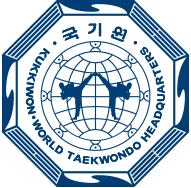All students and their spectators (be they parents, guardians, other relations or friends - collectively "spectators") are expected to abide by the etiquette rules below and breaching these rules after warnings (or if severely in the first case) will result in expulsion from the club
1. Arriving and Entering the Dojang (Hall)
1.1. When students arrive, they are expected to stop in the entrance and bow to the most senior instructor in the room, or to the flags (national flags of England, United Kingdom or Republic of Korea) if any flags are present. If the Head Instructor, Deputy Instructor or Assistant Instructors are not present, then no bow is necessary.
1.2. Students should neatly and quickly put their outdoor clothing, shoes, bags, drink, etc in the designated place and ensure they don't spread too far on to the training floor.
1.3. If a student arrives late, they should quickly put their belongings away as per 1.2. and then come to the side of the dojang, wait for an instructor to acknowledge them, bow to the instructor and then proceed to the rear of the hall to do 5 press-ups (for under 7s), 20 press-ups (for children) and 50 press-ups for adults, then continue to warm-up quickly ready to join in. The press-ups are part punishment for lateness as being late shows a lack of respect for the martial art and the instructors giving up their time to pass it on, and part helping you to quickly warm-up ready to train.
2. Lining Up
2.1. When an instructor tells you to line up, you should quickly form up in to the required number of columns (normally 6, but this may be altered depending on the dojang size or number of students).
2.2. Students should line up in grade order with the most senior student in the front right position, then continuing in grade order across the front row, then starting back on the right position on the second row, working across and so forth.
2.3. Adults of the same grade are always more senior than children. Within an age group and the same grade, those that achieved their grade first are more senior (although if they graded at the same grading, then it is considered even - not which one was on the floor to test first or received their belt first).
3. Leaving the Dojang
3.1. If you need to leave the dojang for any reason during the class, e.g. feeling unwell or needing to go to the toilet, before leaving the hall you must let one of the instructors know, if the instructors are all busy, then let a black belt know, but that should be a last resort, generally the instructors will be available for you to let them know.
3.2. While out of the dojang you should aim to be back as soon as possible, don't waste time and ensure you let the same instructor know when you return to the dojang.
3.3. Should you leave the hall because you felt unwell and decide (or have a spectator decide you should) go home instead of continue to train, you must return to the hall to tell the same instructor that you are leaving.
3.4. The instructors will aim to allow one drink break per hour training session approximately in the middle of the session. This will be given to all students at the same time to reduce the risk and disruption of having students leave the class at odd moments to get a drink.
4. Correct Clothing
4.1. Students must always wear a clean Taekwondo uniform (dobok); all uniforms must be either provided by Stevenage Taekwondo Club, WTF approved with a current WTF logo on them, or by express permission of the Head Instructor. You must wear your current ranked belt. If a student is unable to for any reason, they must tell an instructor and the instructor will decide whether it is acceptable for the student to train or not.
4.2. Long hair should be neatly tied back with a single band/scrunchie, solid hair bands must not be used nor hair clips.
4.3. Fingers and toenails must be neatly trimmed with no sharp corners. No jewelery should be work of any kind, including but not limited to: rings, piercings (ears or otherwise), bracelets, wrist-bands, etc.
4.4. Females may wear a plain white t-shirt/sports top under their dobok, or sew up the bottom of the V-neck by no more than a third of the length of the V. If males have a reason that they need to wear a top under their dobok, this is only possible if the prior permission of the Head Instructor has been given.
4.5. Headwear including hats, headscarves or burkas must not be worn during training. We understand that religions have a right to express themselves in any way they please, but they pose a risk to visibility and that is unacceptable to the club as the student is participating in a combat sport.
5. Greeting/Receiving
5.1. At the start and end of the class, the instructor or a senior student will call the whole class to attention with the Korean command "Cha ryeot", this should be feet together and fists by the sides of the legs, without flapping/slapping the arms. They will then call the class to bow to the main instructor of that class with "Kyong Ye", this should be a bend to about 45 degrees of the neck and 30 degrees from the waist. The eyes must be kept down during bowing, please don't believe martial arts movies, it's very disrespectful to keep the eyes up.
5.2. Before and after partner work, before switching partners if this happens, students must bow to each other when requested by an instructor. To not do this shows great disrespect for someone that is about to/has just worked with you to help make you better.
5.3. When passing something to a senior or equal grade or receiving something from them, the passer should turn the item to be received (e.g. paddle handle towards the receiver) and then should either use two hands or use their right hand with their left hand touching under the elbow. The senior grade can use one hand as normal.
6. Sportsmanship
6.1. It's very important that all students remember that while they are taking part in a contact and combat sport, Taekwondo is an individual journey of self-improvement and skill-learning and that their classmates are there to help each other on that individual journey.
6.2. If one student gets hurt during partner work, be it after an intentional kick or an accidental impact, their partner should stop the exercise to ensure the hurt student is OK (and apologise if it was an accidental impact). If they don't confirm they are OK, the non-hurt student should get the attention of an instructor to check on their partner.
6.3. In the event that one student is distracted (maybe their pads are twisted, belt is coming undone or they have other pairs of fighters too near them) then their partner should be aware of this and pause to allow the situation to be resolved, rather than capitalise on their distraction.
7. Instructors Teach, Students Learn (Spectators Watch)
7.1. The club instructors give up their time freely, none of us take salaries or per-session payments from the club and we do this for the love of the students. The instructors do their best to pass on Taekwondo as accurately as we are able (and undergo training from the best instructors available to ensure that we understand Taekwondo as well as we can). The instructors always aim to help every student reach their potentially, safely and ideally while enjoying the sessions.
7.2. Students should give their best efforts to learn Taekwondo at all times. They should aim to also practice the things they are learning at home, to ensure that lessons don't need to be repeated multiple times, the knowledge needs embedding properly. They must treat the other students and instructors with respect and follow instructions given by the instructors at all times and promptly.
7.3. Spectators are there only to spectate. They should not be coaching their students from the sideline, that is the job of the instructors. They must not enter the training floor while the lesson is in progress, must not shout from the rear of the hall, must not walk down the sides of the hall. They must not encourage their student to take additional drinks breaks nor when a drinks break is called bring a drink on to the floor for their student. If the spectator doesn't like an aspect of the club, they are free to encourage their student to leave, but they must not be involved during a training session unless specifically invited or their student may be expelled
8. Promotion Tests
8.1. There are two aspects to being ready to test for a new belt - time eligibility and skills eligibility. In Korea, it's fairly standard that they require a MINIMUM of 20 sessions between geup (coloured belt) tests. In STC we require a MINIMUM of 16 sessions, to make allowances for occasionally having summer holiday, family events, etc. However, it is terrible etiquette to then say "I/my child almost has enough sessions, it wasn't my/their fault I missed one or two, can you make an exception". The answer is simple, test next time. The journey through the belts is not a race.
8.2. As above, having enough sessions is one part of being ready, the other part is being assessed by a Master Instructor (4th Dan or above) as being above the standard required for that belt. These assesments are done in the final two weeks before the test. If a master feels the student is almost there and can fix things before the grading, they may assess them more than once. However, if they make a "you're not ready" decision, then that is final. Particularly for parents, do not try to "argue their case", it doesn't matter how the student compares to other students, or how ready a parent feels they are. If the parent is a master instructor themselves, then they can promote their child. Otherwise, please remember the decades of experience that the master instructors have, and trust that if we say they aren't ready then we mean it. The two worst parts about gradings are telling students they aren't ready to test and even worse, failing them on the day. We don't want to do either, but we'd rather tell them they aren't ready than cause embarassment when they fail on the day. As per 8.1. - it's not a race, test next time.
8.3. On the day please make sure you turn up on time and allow enough time in your personal schedule to stay until the end. If you turn up late due to an unforeseen event, you may be told you aren't eligible to test at the examiners' discretion. If you know you will be late due to a prior engagement, then text next time, it's not a race! If the student needs to leave early from the test, except in the case of obvious sickness/illness, then this will be an automatic failure. If you are unable to make the test date, then wait until the next one - there will not be any extra tests other than on the announced test dates (and we generally announce them at least one year in advance so that people have enough time to arrange their schedules accordingly. Respect is very important in Taekwondo, so not showing the testing process, your classmates and master instructors the respect of being there for the whole of the test is unacceptable.
8.4. It's always been said that "it's bad etiquette to ask to be promoted, and even worse to refuse to test when told to do so". Either of these actions shows a lack of faith in the masters' ability to assess progress/readiness. If you feel that you know better than the master instructor talking to you about this, you're welcome to find another club where you think the instructor knows more than you. This is a cause of great offence, so please don't do it.
8.5. If you are spectating a test, taking photographs is acceptable. However, please put your phones in silent/flight mode so rings/dings don't disturb the candidates testing. It's OK for you to drink/eat, but again, please remember that the candidates are not allowed food/drinks on the floor so it may make them feel penalised if you're sitting there eating a feast.



